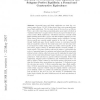85 search results - page 7 / 17 » Binary Factor Analysis with Help of Formal Concepts |
BMCBI
2004
13 years 8 months ago
2004
Background: Metabolic pathway analysis has been recognized as a central approach to the structural analysis of metabolic networks. The concept of elementary (flux) modes provides ...
IJON
2008
13 years 8 months ago
2008
Presence-absence (0-1) observations are special in that often the absence of evidence is not evidence of absence. Here we develop an independent factor model, which has the unique...
ICCS
2005
Springer
14 years 2 months ago
2005
Springer
Abstract. Morphisms constitute a general tool for modelling complex relationships between mathematical objects in a disciplined fashion. In Formal Concept Analysis (FCA), morphisms...
HICSS
2008
IEEE
14 years 3 months ago
2008
IEEE
Understanding how citizens value e-government services is critical to the success of these initiatives. This paper describes the development of a model to identify factors that in...
CORR
2007
Springer
13 years 8 months ago
2007
Springer
Abstract. Sequential game and Nash equilibrium are basic key concepts in game theory. In 1953, Kuhn showed that every sequential game has a Nash equilibrium. The two main steps of ...


